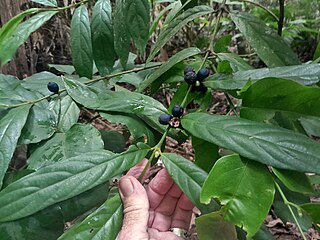Syndyophyllum is a plant genus of the family Euphorbiaceae, first described as a genus in 1900. It is native to Sumatra, Borneo, and New Guinea.
- Syndyophyllum excelsum K.Schum. & Lauterb. - New Guinea
- Syndyophyllum occidentale Welzen - Sumatra, Borneo

Harpullia is a genus of about 27 species of small to medium-sized rainforest trees from the family Sapindaceae. They have a wide distribution ranging from India eastwards through Malesia, Papuasia and Australasia to the Pacific Islands. They grow naturally usually in or on the margins of rainforests or associated vegetation.

Licuala is a genus of palms, in the tribe Trachycarpeae, commonly found in tropical forests of southern China, Southeast Asia, the Himalayas, New Guinea and the western Pacific Ocean islands.

Leea is a genus of plants in the family Vitaceae, subfamily Leeoideae, that are native to parts of central Africa, tropical Asia, Australia and Melanesia. It was previously placed in its own family, Leeaceae, based on morphological differences between it and other Vitaceae genera. These differences include ovule number per locule, carpel number, and the absence or presence of a staminoidal tube and floral disc. Pollen structure has also been examined for taxonomic demarcation, though studies have concluded that the pollen of Leeaceae and Vitaceae suggests the families should remain separate while other studies conclude that Leea should be included in Vitaceae.

Laportea is a genus of plants in the family Urticaceae. They are herbaceous, either annual or perennial. Like many plants of the Urticaceae, they have stinging hairs. There are stinging and non-stinging hairs on the same plant. The genus was named after the French naturalist Francis de Laporte de Castelnau.
Lasianthus macrocalyx, synonym Lasianthus grandifolius, is a species of flowering plant in the family Rubiaceae, endemic to Tanzania. It was first described by Karl Moritz Schumann in 1900.
Pentagonia spathicalyx is a species of flowering plant in the family Rubiaceae, native to western South America to north Brazil. It was first described by Karl Moritz Schumann in 1889.

Pseuduvaria is a genus of the plant family Annonaceae and tribe Miliuseae: with a native range is Tropical Asia.
Airosperma is a genus of flowering plants in the family Rubiaceae. It was described by Karl Moritz Schumann and Carl Adolf Georg Lauterbach in 1900. It contains 6 accepted species, all endemic either to New Guinea or to Fiji.
Carl Adolf Georg Lauterbach was a German explorer and botanist.
Afrocalathea is a genus of plants native to Africa. It contains only one species: Afrocalathea rhizantha (K.Schum.) K.Schum, known from Nigeria, Cameroon, Gabon, Cabinda, and Congo-Brazzaville.

Phrynium is a plant genus native to China, India, Southeast Asia, New Guinea and Melanesia. It was described as a genus in 1797.
Pleuranthodium is a genus of plants in the ginger family. Of the 23 known species, 21 are endemic to New Guinea, one to Queensland and one to the Bismarck Archipelago.
Schlechterella is a genus of plants in the family Apocynaceae. It is native to Africa, found in Ethiopia, Kenya, Mozambique, Somalia, Tanzania and Uganda.
Wenzelia is a genus of flowering plants belonging to the family Rutaceae.
A tree in the Moraceae family, Ficus phaeosyce grows in eastern New Guinea, endemic to the nation of Papua Niugini. It is a shade tolerant understorey species, locally very abundant. A range of insect herbivores feed on the plant.
Lauterbachia is a monotypic genus of flowering plants belonging to the family Monimiaceae. The only species is Lauterbachia novoguineensisPerkins.
Pseuduvaria dielsiana is a species of plant in the family Annonaceae. It is native to New Guinea. Carl Lauterbach, the German botanist who first formally described the species using the synonym Goniothalamus dielsianus, named it in honor of Ludwig Diels, another German botanist who also worked on taxa from New Guinea.
Cyperus maranguensis is a species of sedge that is native to parts of eastern Africa. This species was first identified by K.Schum, the first scientific description dating to 1895. The plant is also a part of the Cyperus genus.

Lasianthus chlorocarpus, commonly known as blue rubi, is a plant in the family Rubiaceae native to parts of Malesia, Papuasia and Australia. It is an evergreen shrub growing up to 2 m high in well developed rainforest.








